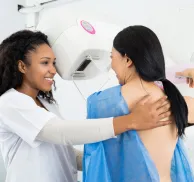If you’re building a career in mammography, two names will shape your training path: the Mammography Quality Standards Act (MQSA) and the American Registry of Radiologic Technologists (ARRT®). MQSA is a federal compliance rulebook that sets minimum training and ongoing practice standards for anyone performing mammograms in the United States. ARRT®, by contrast, is a credentialing body whose Mammography (M) postprimary certification validates your knowledge and clinical experience above those federal minimums. Together, they help ensure safe, high-quality breast imaging and patient care.
The following sections help outline ARRT® certification requirements as well as a MQSA requirements for mammography checklist.
Why Mammography Training Standards Matter
Before delving into the specifics, these rules exist because mammography is a high-stakes exam where positioning, compression, radiation dose, and image evaluation must be consistent to find subtle cancers early. Shared standards keep patient safety and image quality front and center.
The Critical Role of Mammographers in Early Breast Cancer Detection
Mammographers are on the front line of early disease detection — positioning, compressing, communicating, and optimizing technical factors so radiologists can see subtle findings. Uniform qualifications help reduce avoidable repeats and recalls while maintaining diagnostic confidence.
How Training Standards Ensure Patient Safety and Image Quality
Standardized education and experience requirements support safer exams and diagnostic-quality images across facilities. This ranges from positioning and compression to quality control/assurance (QC/QA) checks and modality-specific training (2D full-field digital mammography and 3D digital breast tomosynthesis).
Why It’s Important to Understand Both ARRT® and MQSA Requirements
MQSA defines what’s legally required to perform mammography. ARRT®’s Mammography (M) certification is voluntary but often preferred or required by employers. Knowing both helps you sequence coursework, supervised exams, and continuing education (CE) without compliance gaps.
What Is MQSA and Its Role in Mammography?
Think of the Mammography Quality Standards Act as the federal baseline. It tells facilities (and you) the minimum training, experience, and ongoing education needed before you can perform mammograms independently — and how you maintain that status over time.
Overview of the Mammography Quality Standards Act (MQSA)
MQSA is a federal law administered by the U.S. Food & Drug Administration (FDA). It establishes national personnel qualifications, facility quality systems, and continuing requirements so patients receive consistently high-quality mammograms across the U.S.
Federal Requirements for Mammographers in the U.S.
Before performing mammography independently under MQSA, technologists must:
Be state-licensed in radiography or hold an FDA-recognized general radiography certification — e.g., ARRT® (R).
Complete 40 contact hours of mammography-specific training under a qualified instructor. The 40 hours must include breast anatomy/physiology, positioning/compression, QA/QC, and imaging patients with implants.
Perform 25 mammography exams under direct supervision of a qualified mammographer (these supervised exams are part of initial training).
Complete at least 8 hours of training in each mammographic modality to be used (e.g., 2D FFDM and 3D DBT) before using that modality independently.
Maintain continuing education: 15 CE in mammography every 36 months.
Maintain continuing experience: 200 mammograms every 24 months.
Sequencing note: Facilities commonly schedule didactic hours and supervised cases in the order that best fits operations, so long as all initial MQSA elements are completed before independent practice. California adds state-specific steps and requires a state mammography certificate; passing ARRT® (M) can substitute for the state exam when applying for that certificate. Always confirm California sequencing and documentation with CDPH.
Minimum Initial Training and Supervised Clinical Examinations
Initial training comprises the 40 hours plus the 25 supervised exams noted above, and direct supervision means a qualified technologist is physically present to observe and correct as needed. MQSA also requires 8 hours of training for each modality you will use independently.
Continuing Education and Continuing Experience Mandates
After initial qualification, you must maintain 15 CE/36 months in mammography and 200 exams/24 months. If you fall short, MQSA specifies requalification steps (such as performing 25 supervised exams again) before resuming independent work.
What Is ARRT® and Its Role in Mammography?
Founded in 1922, the American Registry of Radiologic Technologists provides a nationally recognized, voluntary credential — Mammography (M) — that sits on top of MQSA. It verifies you’ve completed structured education, documented clinical experience, and passed a standardized exam. The organization provides certification in a variety of other radiology specialties, too, in an effort to uphold high standards of care for patients.
Overview of the American Registry of Radiologic Technologists (ARRT®)
ARRT® awards postprimary credentials like Mammography (M) to verify discipline-specific education and clinical experience beyond MQSA’s legal minimums, and it sets ongoing maintenance expectations: biennial CE and, for time-limited credentials, 10-year Continuing Qualifications Requirements (CQR).
Eligibility Requirements for Mammography Certification
To pursue ARRT® (M) via the postprimary pathway and meet ARRT® certification requirements, you must:
Meet MQSA initial requirements (e.g., 40 hours and 25 supervised exams) before logging ARRT® activities.
Complete ARRT®’s Clinical Experience Requirements — specific logged procedures verified in ARRT®’s online tool — within the 24 months before you apply.
Complete 16 hours of structured education in mammography within the 24 months before you apply (covering required content areas).
Apply, schedule, and sit for the ARRT® exam within 365 days of your application being processed (or reapply/pay to open a new window).
Here are additional points that are important to note:
Legal vs. optional – MQSA and being a registered radiography technologist, or RT(R), is required to practice; ARRT® (M) is not required by federal law. Some states or employers prefer/require it, but MQSA alone governs federal compliance.
California reminder – California issues a state Mammographic Radiologic Technology certificate. If you pass ARRT® (M), California will issue that state certificate without a separate state exam; otherwise, you must pass the California mammography exam.
Clinical Experience Documentation and Structured Education
ARRT® requires you to document and verify specific procedure categories (patient exams, QC tasks, image evaluation, etc.), with limits on how many entries you can log per day and a 24-month look-back window. Structured education must include at least one credit in each content category (Patient Care, Image Production/QA, Procedures) for a total of 16 hours.
Exam Requirements and Ongoing CE for Certification Maintenance
After you pass, you’ll renew annually and complete 24 CE credits every two years. If your ARRT® credential is time-limited (earned on/after Jan. 1, 2011), you’ll also complete CQR every 10 years.
Key Differences Between ARRT® and MQSA
Both pathways complement each other, but they serve distinct purposes. Here’s a quick comparison of the two:
Certification vs. Compliance — Different Purposes
MQSA entails federal compliance to legally perform mammography (initial training + supervised exams + modality training + ongoing CE/experience).
ARRT® (M) is a voluntary professional certification that validates structured education, documented clinical experience, and exam performance within defined windows.
ARRT® Focus on Credentialing, MQSA Focus on Federal Quality Standards
MQSA sets uniform national minimums and inspection criteria; it does not require ARRT® (M).
ARRT® adds a national credential with 24-month documentation windows for education/experience and a 365-day exam window after application.
Tips for Navigating ARRT® and MQSA Requirements Successfully
To help professionals and facilities adhere to industry requirements, the FDA lays out a comprehensive document entitled “Mammography Quality Standards Act and Regulation Amendments: Small Entity Compliance Guide” detailing specific recommendations. Additionally, the ARRT® Board provides documentation on its Mammography Clinical Experience Requirements and Structured Education Requirements for Mammography.
Backed by these resources, keep in mind the following tips regarding MSQA and ARRT®:
Keep a Detailed Log of Clinical Experience and Exams Performed
Document procedures as you go in ARRT®’s online clinical experience tool, including QC activities and time spent sitting with the radiologist. Your facility must also maintain a personnel file with proof of your MQSA qualifications, so keep copies of CE, modality training, and supervised exams in your own records.
Use Accredited Programs That Meet Both Standards
Choose initial training and CE from approved providers so your hours count toward both MQSA and ARRT® structured education. Cross-check that course content maps to ARRT®'s Mammography Structured Education categories and MQSA’s required topics (anatomy/physiology, positioning/compression, QA/QC, implants).
Stay Ahead of CE Deadlines With Annual Planning
Put MQSA’s 15 CE/36 months and ARRT®’s 24 CE/2 years on your calendar now, then plan continuing education that can satisfy both timelines where allowed. If you ever fall short on MQSA experience (200 exams/24 months), start requalification before inspection to avoid interruptions.
Consult Supervisors or Regulatory Advisors When in Doubt
Your lead technologist, medical physicist, or compliance officer can help interpret inspection findings and documentation expectations as well as ensure your file remains inspection-ready under MQSA. When state rules apply (like California’s state certificate), verify details with the regulator.
Final Takeaway: ARRT® and MQSA — Two Standards, One Goal
When it comes to the MQSA requirements for mammography checklist, these rules set the legal baseline for technologist qualifications and ongoing practice. Meanwhile, ARRT® (M) is a professional credential that signals advanced preparation and can strengthen your career prospects — especially at facilities that prefer or require it. Know which pieces are mandatory and which are career-advancing, then plan your coursework, supervised exams, and CE so you never fall out of compliance.
At MTMI, we invite medical imaging professionals to explore our mammography training and CE. Start your Initial Mammography Training Course (40 hours), Mammography Registry Review for ARRT® exam prep (16 CE hours), or other specialized programs today!







